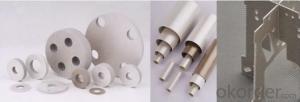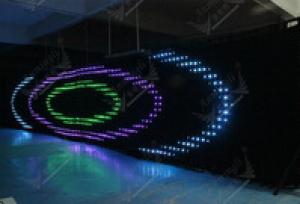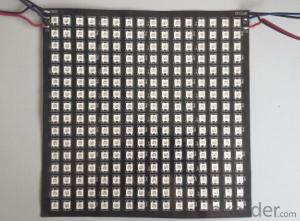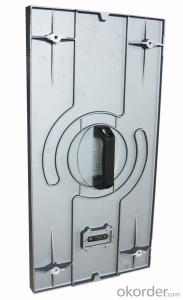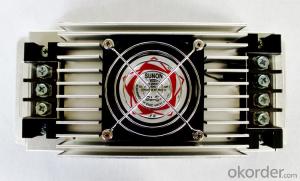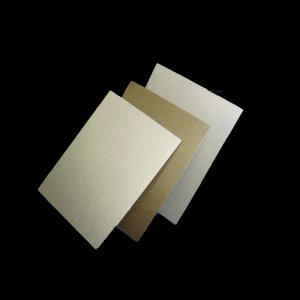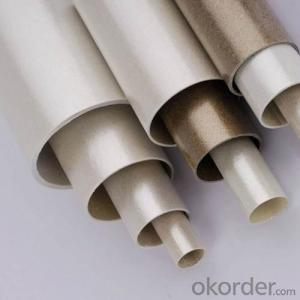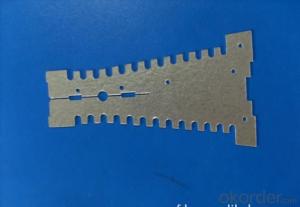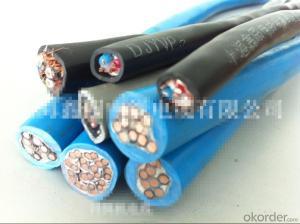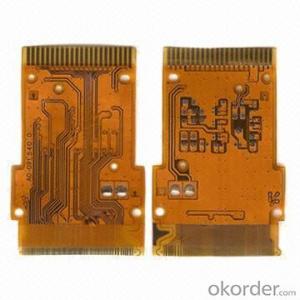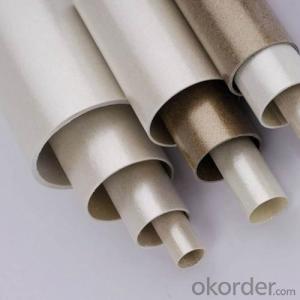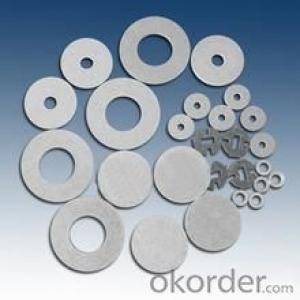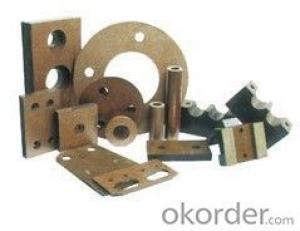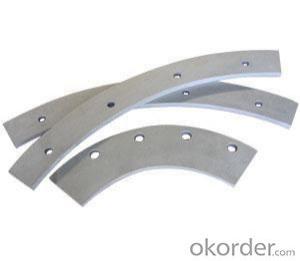Mica Parts Used for Induction Furnace for Industry
- Loading Port:
- Shanghai
- Payment Terms:
- TT OR LC
- Min Order Qty:
- 100 pc
- Supply Capability:
- 100000 pc/month
OKorder Service Pledge
OKorder Financial Service
You Might Also Like
1. Introductions:
Mica is a rigid substrate able to withstand very high temperatures and are suited for applications up to 500°F (260°C). Mica heating elements offer several distinct advantages over other flexible heater technologies, including extremely low leakage, lower material costs, and higher operating temperatures. Our mica heating element is made by detail order requirments.
2. Applications:
Typical applications of mica heating elements are air heaters, enclosure systems, food service equipment, process and packaging equipment.
3. Main features of Mica Parts:
Mica heating elements offer several distinct advantages over other flexible heater technologies, including extremely low leakage, lower material costs, and higher operating temperatures. Our mica heating element is made by detail order requirments.
4. Technical Parameters:
MICA SHEET -----Technical data | ||||||||
ITEM | UNIT | RM | RP | RM-T | RP-T | FM | FP | |
Hardness |
| Rigid | Rigid | Rigid | Rigid | Flexible | Flexible | |
Mica paper |
| Muscovite | Phlogopite | Muscovite | Phlogopite | Muscovite | Phlogopite | |
Thickness | mm | 0.1-2.0 | 0.1-2.0 | 3.0-50 | 3.0-50 | 0.1-2.0 | 0.1-2.0 | |
Mica content | % | ≥90 | ≥90 | >88 | >88 | ≥90 | ≥90 | |
Bond Content | % | <10< span=""> | <10< span=""> | <12< span=""> | <12< span=""> | <10< span=""> | <10< span=""> | |
Density | g/m 3 | 1.6~2.45 | 1.6~2.45 | 2.1~2.4 | 2.1~2.4 | 1.6~2.45 | 1.6~2.45 | |
Heat | Continuous | ℃ | 500 | 700 | 500 | 700 | 500 | 700 |
Peak | ℃ | 700 | 900 | 700 | 900 | 700 | 900 | |
Heat loss at 500℃ | % | <1< span=""> | <1< span=""> | <1< span=""> | <2< span=""> | <1< span=""> | <1< span=""> | |
Heat loss at 700℃ | % | <2< span=""> | <2< span=""> | <1< span=""> | <2< span=""> | <2< span=""> | <2< span=""> | |
Flexural strength | Mpa | >160 | >140 | — | — | <1< span=""> | <1< span=""> | |
Water absorption 24h/23°C | % | <1< span=""> | <1< span=""> | <1< span=""> | <2< span=""> | — | — | |
Dielectric strength | KV/mm | >20 | >20 | >15 | >15 | >15 | >15 | |
Volume | 23℃ | ΩNaN | >1017 | >1017 | >1017 | >1017 | — | — |
500℃ | ΩNaN | >1012 | >1012 | >1012 | >1012 | — | — | |
Smoking Test | s | <4< span=""> | <4< span=""> | — | — | — | — | |
FAQ
We have organized several common questions for our clients,may help you sincerely:
--------What is the use of mica parts?
Mica laminate and washers made of our own high quality mica plates are used for home appliances, electro-magnets, micro-sensitive control gear etc
---------Which type of mica parts we can produce?
1. Rigid mica parts or Flexible mica parts
2. Muscovite mica parts or phlogopite mica parts
3. Thin mica parts or thick mica parts
4. All the special sized mica parts need drawing.
----------what advantages of mica parts?
1. Good high voltage insulation materials
2. Do not easily break up
3. Easily produce special size
- Q:Who knows what are the ability of 1300 degrees above the high temperature, insulation materials?
- Such as tungsten, molybdenum, tantalum, niobium, vanadium, chromium, titanium, zirconium and other refractory metals and rare earth metal borides, carbides, nitrides, silicides, phosphides and sulfides; the latter such as boron carbide, Silicon carbide, boron nitride, silicon nitride, boron phosphide, silicon phosphide and the like. The latter has a very important use, can be used as high temperature refractory materials (such as abrasive, mold, nozzle, high temperature thermocouple casing), heat-resistant materials (such as rocket structure components, nuclear engineering materials, electric components), electrical materials Such as high temperature thermocouple, ignition electrode), in addition to chemical resistance materials and hard materials.
- Q:What is the thermal aging and electrical aging of insulating materials?
- Insulation materials in electrical equipment during the operation, due to the long-term effects of various factors, there will be a series of irreversible physical and chemical changes, resulting in its electrical performance and mechanical properties decline, commonly known as aging. There are many factors that affect the aging of insulating materials. The main aging forms are environmental aging, heat aging and electrical aging.
- Q:There are a lot of online about this, but still do not understand. If the insulation resistance is high enough, hit the pressure should also be qualified ah. There is insulation test itself when the current flow is not large, because the rock table resistance is great. But hit the pressure, I do not know is not a direct high pressure drop in the test product above, there is no great resistance to interference?
- People also know that the insulation Megohmmeter is issued by the DC, and because of the relationship between the instrument resistance, the actual output current is very small, but for the withstand voltage test equipment, the internal AC transformer, the output voltage and current Of the capacity, if the equipment capacity is insufficient, the test object when the required voltage is not necessarily able to achieve, so the output current is still relatively large, which is resistant to voltage test is easy to breakdown the test object, and insulation Resistance value is very low case will not breakdown the reasons for the test object.
- Q:What are the electrical insulation materials
- Electrical insulation materials are wood, cotton, paper, oily paint, asphalt paint, polyester film, glass cloth, mica, glass fiber, asbestos, composite silicon organic polyester paint, quartz, glass, porcelain material.
- Q:What is the 8 ° C rule for insulating materials?
- The service life will be greatly shortened, such as ATR insulation material limit working temperature of 105 ℃, when the ultimate working temperature of 8, the life will be reduced by about half, which is the so-called 8 ℃ thermal deterioration rules
- Q:What insulating materials are used for transformers
- There are also NOMEX? insulation plates for the mat and the support structure. The insulation between high and low pressure is made of 0.76mm thick NOMEX? cardboard. Its impregnation process uses multiple VPI vacuum, pressure impregnation, high temperature drying (drying temperature of 180-190 ℃). At FPT, the highest voltage of this transformer is made to 34.5kV and the maximum capacity is 10000kVA. This technology is UL certified in the United States. Domestic transformer manufacturers use NOMEX? insulation materials and DuPont's manufacturing specifications (HV-1 or HV-2) and Reliatran Raytheon TM transformer technology standards such as the manufacture of H Type insulated SG-type dry-type transformers and the United States FPT's FB-type transformer has similarities, but the domestic product coil VPI impregnation process is different from the FPT company, it does not impregnate the entire transformer body, and only the coil impregnated. The whole body impregnated package integrity is good, but not only beautiful, but also in the processing must be done before the relevant product testing. Dipping paint is also easy to be filthy, relatively speaking in China the latter is more reasonable.
- Q:The electrical equipment in the classroom which uses insulating material
- Classrooms in the electrical equipment are used insulating material, but with the number and location of different.
- Q:What is the electrical performance of insulating materials
- The electrical insulating material is a material that is electrically insulated from the device and has a certain mechanical strength, typically having a resistivity of 106 to 1019.cm. Their function in electrical technology is as follows: 1 Insulate the conductor from the other parts; 2 Separate the conductors of different potentials 3 Provide the conditions for the energy storage of the capacitor 4 Improve the potential gradient in the high voltage electric field.
- Q:What is the main purpose of insulating materials?
- As the insulating material has a certain degree of insulation strength, a variety of electrical equipment, all kinds of safety equipment (electrical pliers, test pen, insulated gloves, insulation rods, etc.), a variety of electrical materials, factories are required to allow a certain voltage, For the rated voltage. The voltage to be used shall not exceed its rated voltage value in order to avoid accidents.
- Q:Insulation material and the definition of the role of the best professional insulation materials website for my reference
- The main indicators affect the performance of insulating materials 1, insulation resistance, resistivity: resistance is the reciprocal of conductance, the resistivity is the resistance per unit volume. The smaller the conductivity of the material, the greater the resistance, the reciprocal relationship between the two, for the insulation material, always want the resistivity as high as possible. 2, the relative dielectric constant and dielectric loss tangent:
1. Manufacturer Overview |
|
|---|---|
| Location | |
| Year Established | |
| Annual Output Value | |
| Main Markets | |
| Company Certifications | |
2. Manufacturer Certificates |
|
|---|---|
| a) Certification Name | |
| Range | |
| Reference | |
| Validity Period | |
3. Manufacturer Capability |
|
|---|---|
| a)Trade Capacity | |
| Nearest Port | |
| Export Percentage | |
| No.of Employees in Trade Department | |
| Language Spoken: | |
| b)Factory Information | |
| Factory Size: | |
| No. of Production Lines | |
| Contract Manufacturing | |
| Product Price Range | |
Send your message to us
Mica Parts Used for Induction Furnace for Industry
- Loading Port:
- Shanghai
- Payment Terms:
- TT OR LC
- Min Order Qty:
- 100 pc
- Supply Capability:
- 100000 pc/month
OKorder Service Pledge
OKorder Financial Service
Similar products
New products
Hot products
Hot Searches
